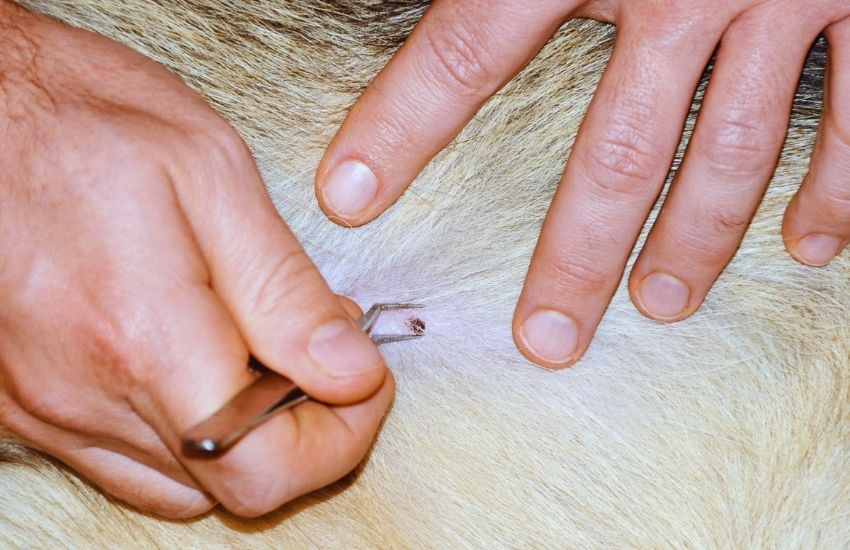shelter pets in need
Each order helps pets in need

You and your pup are excited to get outside and enjoy the warm weather this spring. But along with all the nice green grass, colorful flowers, and sunny weather, spring also means the return of lots of little critters like bees, wasps, fleas, mosquitoes, and ticks . . . just waiting to latch onto your dog and hitch a ride.
Tick bites carry diseases, so getting them dealt with right away is crucial. So, if you catch a tick crawling on your pup's fur, don't fret! Here are essential details about ticks and how to remove them to keep your pooch happy and healthy!
Ticks—nature's little vampires. These blood-sucking arachnids latch onto our furry friends and go to town. You need to know your enemy before you can get rid of these freeloaders.
These arachnids are external parasites that feed on mammal blood, including dogs, cats, and, unfortunately, humans. The little buggers crawl around in bushes and long grass waiting to hitch a ride on passersby.
Once aboard, ticks insert their mouthparts into the skin and start slurping away. Their saliva contains an anesthetic, so the poor thing they latched on won't feel it at first.

Ticks see your dog as an all-you-can-eat buffet. Once they hitch a ride, they latch on and feed, gorging on your pup's blood. They also transmit diseases that can make your dog seriously ill. In addition to disease, ticks themselves can directly harm your dog:
Ticks are more than just a nuisance. Protect your pup through tick prevention medication, routine checks, and proper removal.
Ticks can carry different diseases that can potentially endanger your pet's life. Let's review the creepy-crawly contagions ticks transmit so you know what to watch out for.
Transmitted by deer ticks, Lyme disease can cause fever, lethargy, and joint pain in dogs. If left untreated, it can lead to long-term joint inflammation and kidney damage. The telltale sign is a bullseye rash at the bite site, but not all dogs develop this. Get your pup tested if you notice any symptoms.
Carried by the lone star tick, ehrlichiosis induces symptoms like fever, lethargy, loss of appetite, and bruising. It can be difficult to diagnose as the signs are common to many illnesses. Blood tests can confirm the infection. Early treatment with doxycycline is critical to preventing complications.
Also spread by the deer tick, anaplasmosis leads to similar symptoms as ehrlichiosis, including fever, joint pain, and lethargy. It requires the same treatment (doxycycline) to avoid issues like blood clots or organ failure in severe cases.
The bottom line is if a tick has bitten your dog, monitor them closely for symptoms in the coming weeks and call your vet immediately if anything seems off. Early detection and treatment of these diseases is critical. Your dog depends on you, so be vigilant and get them proper care as soon as possible if they develop any signs of infection.

Here are some easy tips on removing a tick from your dog, courtesy of Blue Buffalo. Be sure to check their website for other excellent pet care information.
Removing a tick, or worse, ticks from your dog may be unpleasant, but it is critical to do it promptly and correctly.
Tick prevention is the key to effective tick control. Prevent ticks by checking your dog's skin regularly and removing them immediately so you can stop them from worsening.
There are many commercial products that you can use to not only get rid of adult ticks but also their eggs. These products can also instantly kill any present ticks on your pet for up to two weeks.

You can opt to remove a tick or fleas safely using natural methods. Because natural flea and tick management is gentle, it is safe for your pet. For maximum effectiveness, natural prevention and control methods should be used in combination with one another.
Fleas can be caught before they latch onto your dog's skin by regularly combing using a fine flea comb. Vacuum rugs and furnishings, as well as wash pet bedding regularly.
Look for lawn products containing beneficial microbes that consume flea and tick larvae. They are safe for your grass, pets, and beneficial insects such as ladybugs.
Getting dog hair on your shirt is inevitable when you're always with your doggy companion. Turn it a fashion statement instead with our This Is My Dog Hair t-shirt! The perfect tee to put on when you go to the park to brush your dog!
Shop gifts and apparel for dog lovers! 25% of proceeds go to animal rescues and sanctuaries.
Yes, removing an attached tick from your dog is typically safe if done correctly. The key is to remove the tick in its entirety, including the head and mouthparts.
While removing an attached tick is usually safe, the tick itself may have already transmitted bacteria or parasites before you noticed and removed it. Watch your dog closely for symptoms after tick removal, and contact your vet immediately if you notice anything wrong.
Ticks can feed on dogs for 7 to 10 days before dropping off on their own. The tick's goal is to get a complete blood meal to continue its lifecycle. However, the longer a tick stays attached, the higher the risk of disease transmission to your dog.
Fleas and ticks differ in numerous ways, including the parasite type they are: A flea is a wingless bug with six legs that may jump. On the other hand, ticks are arachnids, meaning they have six to eight legs and are linked to spiders.
Leave a comment